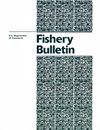Mortality estimates for gray triggerfish (Balistes capriscus) in the northern Gulf of Mexico based on acoustic telemetry
IF 0.8
4区 农林科学
Q3 FISHERIES
引用次数: 0
Abstract
— Gray triggerfish ( Balistes capriscus ) is a common resident of reef habitats in the northern Gulf of Mexico. It is targeted by fishermen and recently considered not overfished. However, stock status is highly depen- dent on indirect mortality estimates from sport and commercial fishery landings that may have errors. To enhance management efforts, we used acoustic telemetry to directly estimate fishing mortality ( F ), natural mortality ( M ), and total mortality ( Z ) for gray triggerfish on artificial reefs in the northern Gulf of Mexico. Over the study period, 30 fish emigrated, 4 fish were caught by fishermen, 4 fish died of natural causes, 8 fish were active when their transmitter battery expired, and 3 fish were still active at the end of the study. Annual F was 0.23 (95% confi- dence interval [CI]: 0.07–0.50) and was lower than in past stock assessments. This rate indicates that earlier man- agement efforts were successful. However, our F estimate is possibly greater than a recent management goal of 0.17 based on a 30% spawning potential ratio. Therefore, gray triggerfish stocks may still be experiencing overfishing. Annual M was 0.25 (95% CI: 0.07–0.57) and supports the management applied M of 0.28. Annual Z was 0.48 (95% CI: 0.18–0.85), which was not considered sustainable under the most recent stock assessment and supports the management decision to increase fishery restrictions.基于声波遥测的墨西哥湾北部灰色扳机鱼(Balistes capriscus)死亡率估计
--灰三角鱼(Balistes capriscus)是墨西哥湾北部珊瑚礁栖息地的常见居民。它是渔民的目标,最近被认为没有过度捕捞。然而,种群状况在很大程度上取决于体育和商业渔业登陆的间接死亡率估计,这些估计可能存在错误。为了加强管理工作,我们使用声学遥测直接估计了墨西哥湾北部人工礁上灰三角鱼的捕捞死亡率(F)、自然死亡率(M)和总死亡率(Z)。在研究期间,有30条鱼移民,4条鱼被渔民捕获,4条鱼因自然原因死亡,8条鱼在发射器电池过期时仍处于活动状态,3条鱼在研究结束时仍处于活跃状态。年F为0.23(95%置信区间[CI]:0.07–0.50),低于过去的库存评估。这个比率表明早期的管理工作是成功的。然而,我们的F估计可能大于最近基于30%产卵潜力比率的0.17的管理目标。因此,灰三角鱼种群可能仍在经历过度捕捞。年度M为0.25(95%置信区间:0.07–0.57),支持管理层应用0.28的M。年度Z为0.48(95%置信区间:0.18–0.85),根据最新的种群评估,这是不可持续的,并支持管理层增加渔业限制的决定。
本文章由计算机程序翻译,如有差异,请以英文原文为准。
求助全文
约1分钟内获得全文
求助全文
来源期刊

Fishery Bulletin
农林科学-渔业
CiteScore
1.70
自引率
12.50%
发文量
76
审稿时长
>24 weeks
期刊介绍:
The quarterly Fishery Bulletin is one of the oldest and most respected fisheries journals in the world. It has been an official publication of the U.S. Government since 1881, under various titles, and is the U.S. counterpart to other highly regarded governmental fisheries science publications. It publishes original research and interpretative articles in all scientific fields that bear on marine fisheries and marine mammal science.
 求助内容:
求助内容: 应助结果提醒方式:
应助结果提醒方式:


